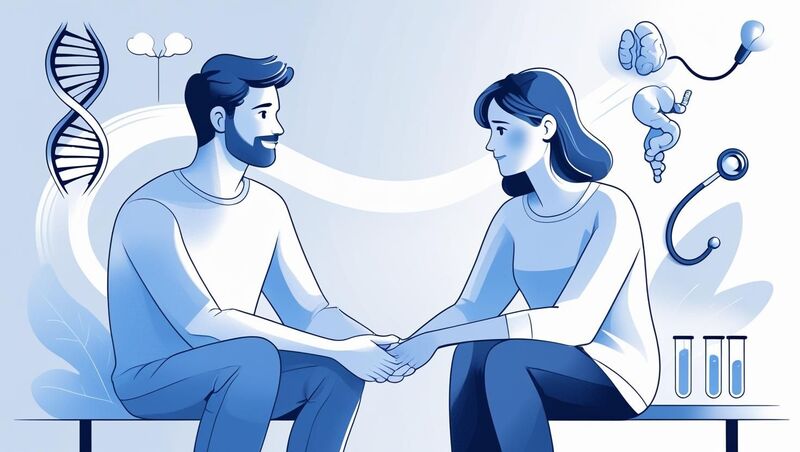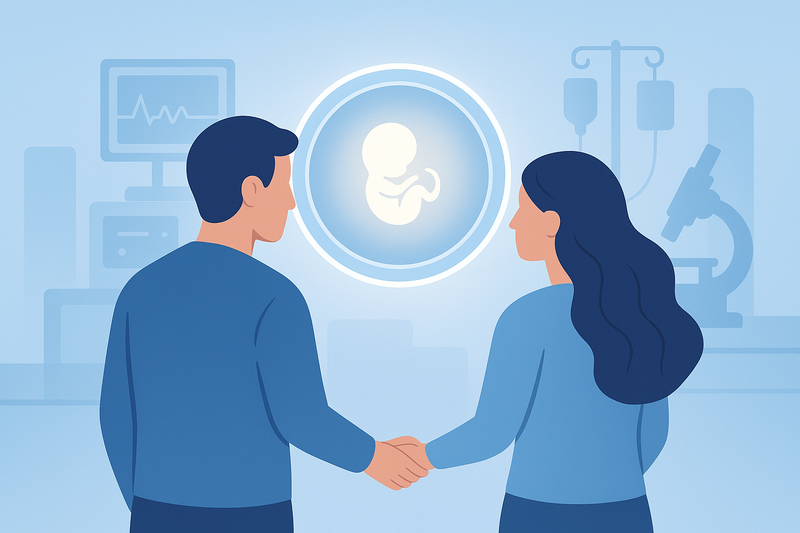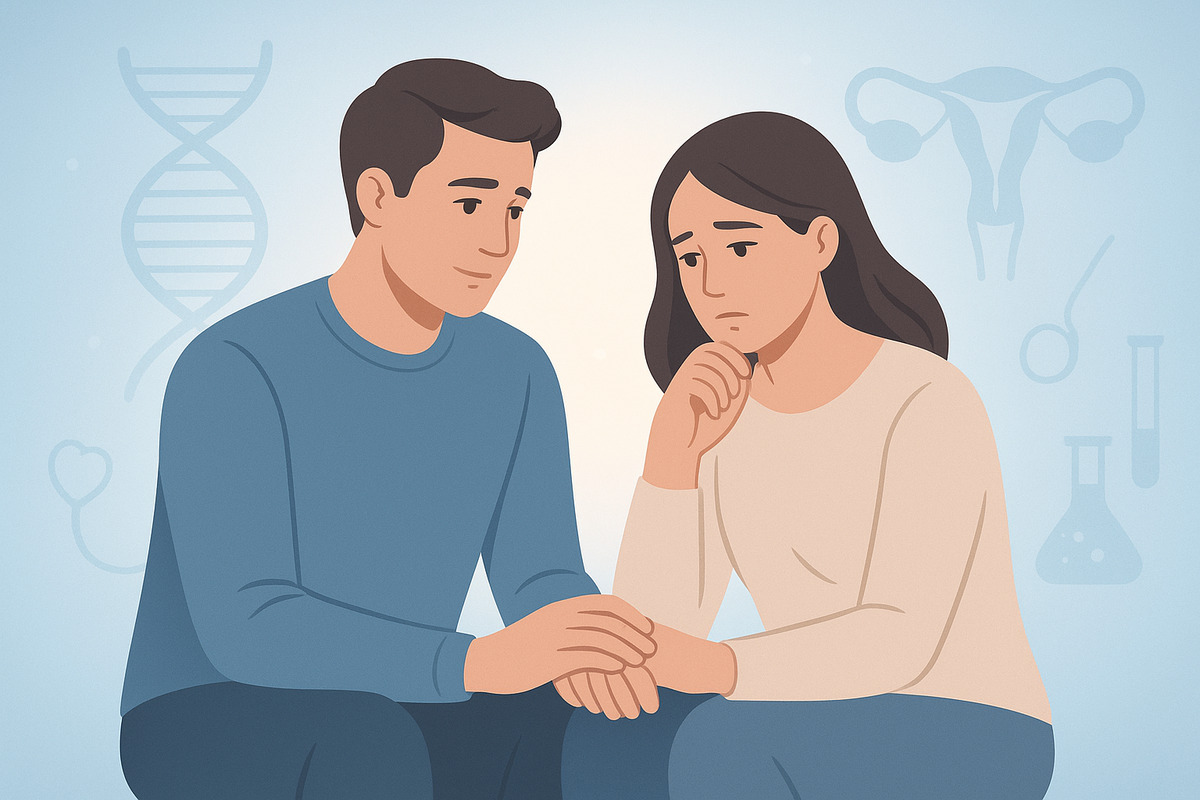Infertility is a challenging medical condition characterized by the inability to achieve pregnancy despite frequent, unprotected sexual activity for a specified period, typically one year for most couples, or six months for women aged 35 or older.
This widespread issue affects millions of people globally, with approximately 48 million couples struggling worldwide. The causes of infertility are diverse, often stemming from health issues in females, males, or a combination of factors, with studies indicating that each partner contributes to about a third of cases, or it remains unexplained.
Key symptoms primarily involve the absence of pregnancy, though some women may experience irregular menstrual periods and men might show signs of hormonal imbalances affecting sperm production or sexual function.
Various types exist, including primary infertility for those who have never conceived and secondary infertility for those unable to conceive again after a previous pregnancy.
Fortunately, a range of safe and effective treatment options, from lifestyle adjustments to advanced reproductive technologies like IVF, offer hope, with a high success rate for many couples.
Addressing underlying disorders and understanding the role of factors like age, hormones, and lifestyle are crucial steps in the journey towards conception.
The proper functioning of the reproductive system in both partners, including healthy egg release (ovulation) from the ovaries and quality sperm from the testicles, is vital for forming a viable embryo and successful implantation in the uterus via the fallopian tubes.
Medical conditions, genetic factors, environmental exposure, and cancer treatment can all play a role. Understanding these complexities is key to navigating the path to parenthood
What is Infertility?

Infertility is defined as the inability to get pregnant despite having frequent, unprotected sexual intercourse for a specific period. For most couples, this period is at least one year. However, if a woman is 35 or older, infertility may be diagnosed after six months of trying to conceive. If a woman is 40 or older, evaluation should be sought after fewer than six months of trying.
This condition affects both men and women. Infertility can occur due to a health issue with either partner, or a combination of factors. It’s a common problem, with approximately 48 million couples worldwide experiencing infertility. In the United States, 1 in 5 women between 15 and 49 years old struggle with primary infertility. Fortunately, many safe and effective treatments are available to boost the chances of getting pregnant.
Types of Infertility:
Infertility can be categorized into different types based on a person’s pregnancy history:
- Primary Infertility: This refers to situations where an individual or couple has never been pregnant and cannot conceive after one year of regular, unprotected sexual intercourse (or six months if the woman is 35 or older). In the U.S., about 1 in 5 women in the 15-49 age range experience primary infertility.
- Secondary Infertility: This type occurs when a person cannot get pregnant again after having had at least one successful pregnancy in the past. Approximately 1 in 20 women in the U.S. struggle with secondary infertility.
- Unexplained Infertility: In some cases, fertility testing does not reveal a clear reason why a woman or couple is unable to get pregnant.
Symptoms of Infertility:

The main symptom of infertility is not getting pregnant. Often, there are no other clear symptoms. However, some individuals may experience additional physical signs:
- For women: Some women with infertility may have irregular menstrual periods or no periods at all. Other symptoms might include pelvic or abdominal pain.
- For men: Some men may show symptoms of hormonal problems, such as changes in hair growth or sexual function. Other potential signs can include penile disorders or issues with ejaculation. Sometimes, male infertility is associated with low testosterone production, which can lead to tiredness, impotence, depression, weight gain, and apathy.
Are there any obvious signs of unhealthy sperm? There are generally no obvious external signs of unhealthy sperm.
The best way to determine the health of sperm, including count and motility, is through a semen analysis performed in a lab.
While some over-the-counter home tests exist, they are not as thorough or effective as lab tests.
When to See a Doctor:
It’s important to know when to seek professional help for infertility.
When should couples seek professional help for infertility? You generally don’t need to see a healthcare professional about infertility unless you’ve been trying to get pregnant for at least one year. However, certain factors warrant an earlier consultation:
1. For women, talk with a healthcare professional sooner if you are:
- Age 35 or older and have tried to conceive for six months or longer.
- Over age 40.
- Experiencing no periods, or irregular or very painful periods.
- Aware of known fertility problems.
- Diagnosed with endometriosis or have a history of pelvic inflammatory disease (PID).
- Had more than one miscarriage.
- Received cancer treatment such as chemotherapy or radiation.
2. For men, talk to a healthcare professional if you have:
- A low number of sperm or other problems with sperm.
- A history of testicular, prostate, or sexual conditions.
- Had treatment for cancer, such as chemotherapy.
- Had hernia surgery.
- Testicles that are smaller than the typical adult size, or swollen veins in the scrotum (varicocele).
- Had infertility with a partner in the past.
- Relatives with infertility problems.
Causes of Infertility:

Many factors can contribute to infertility, and sometimes, no specific cause can be found. Causes can affect one or both partners.
Studies indicate that roughly 33% of infertility cases involve women, 33% involve men, and 33% involve both partners or remain unexplained. Furthermore, 25% of infertile couples have more than one contributing factor.
What common lifestyle factors can impact fertility? Many general risk factors can affect both male and female fertility. These include:
| General Risk Factor | Impact on Fertility |
| Age | Women’s fertility declines slowly with age, especially after mid-30s, and quickly after 37. Men over 40 may be less fertile, with increased risk of birth defects/genetic problems in offspring. |
| Tobacco Use | Lowers chances of pregnancy, makes treatments less effective, increases miscarriage risk for women who smoke. Raises risk of erectile dysfunction and low sperm count in men. |
| Marijuana Use | May affect fertility, more research needed. Linked to negative health effects on unborn babies, increased miscarriage and stillbirth risk during pregnancy. |
| Alcohol Use | No safe level for women trying to conceive or during pregnancy; may contribute to infertility. Heavy drinking in men can lower sperm count and affect sperm movement. |
| Being Overweight | Linked to lower quality of semen in men and increased risk of infertility for both sexes. |
| Being Underweight | Risk for those with eating disorders or very low-calorie diets. |
| Exercise Issues | Lack of exercise contributes to obesity and infertility risk. Frequent, strenuous exercise in non-overweight women can cause ovulation problems. |
| Environmental Toxins | Exposure to pesticides, chemicals, lead, cadmium, mercury, or radiation can affect fertility. |
| Cancer Treatment | Chemotherapy and radiation can affect sperm production and female fertility. |
| STIs | Sexually transmitted infections like chlamydia, gonorrhea, or HIV can impact sperm. Untreated chlamydia can lead to pelvic inflammatory disease (PID) which damages female reproductive organs. |
Causes of Male Infertility:
Male infertility primarily involves issues with the shape, movement (motility), or amount (low sperm count) of sperm. Specific causes can include:
- Conditions affecting sperm production or quality: These include undescended testicles, genetic defects (like cystic fibrosis or Klinefelter syndrome), hormone problems (like low testosterone or disorders of the hypothalamus/pituitary glands), and general health issues such as diabetes or autoimmune diseases. Infections like chlamydia, gonorrhea, mumps, or HIV can also impact sperm. Enlarged veins in the scrotum (varicocele) can negatively affect sperm quality.
- Problems with sperm reaching the female reproductive tract: This can be due to sexual conditions (e.g., premature ejaculation, erectile dysfunction, anejaculation, retrograde ejaculation), physical problems (e.g., blockages in the testicle or tubes), or damage/injury to reproductive organs. Prior surgical sterilization (vasectomy) also prevents sperm from reaching the female reproductive tract.
- Environmental factors: Exposure to pesticides, other chemicals (lead, cadmium, mercury), or radiation can affect fertility. Certain medications (e.g., for bacterial infections, high blood pressure, depression, flutamide, spironolactone, bicalutamide, anabolic steroids) can also impact sperm. Frequent exposure of testicles to heat, such as from saunas, hot tubs, or even holding laptops, may affect sperm production.
- Damage related to cancer and its treatment: Chemotherapy, radiation, or surgical removal of testicles (orchiectomy) can affect sperm production.
Causes of Female Infertility:
Female infertility often stems from issues affecting ovulation, the fallopian tubes, or the uterus. Causes can include:
- Ovulation disorders: These are the most common cause of female infertility and affect the release of eggs from the ovaries. Examples include hormonal problems like polycystic ovary syndrome (PCOS), high levels of prolactin (a hormone for breast milk production), or thyroid imbalances (hyperthyroidism or hypothyroidism). Other underlying causes can be excessive exercise, eating disorders, or tumors.
- Conditions of the uterus: These include growths like uterine polyps, issues with the shape of the uterus, or problems with the cervix. Uterine fibroids, non-cancerous tumors in the uterine wall, can block fallopian tubes or prevent a fertilized egg from implanting.
- Fallopian tube damage or blockage: Often caused by swelling (salpingitis), which can result from pelvic inflammatory disease (PID) due to infections of the reproductive organs. Chlamydia is a significant risk factor for PID and thus for fallopian tube damage.
- Endometriosis: This condition involves tissue similar to the uterine lining growing outside the uterus, affecting the function of the ovaries, uterus, and fallopian tubes. About 30% to 50% of women with endometriosis experience infertility.
- Primary ovarian insufficiency (POI): This occurs when the ovaries stop working correctly, and menstrual periods end before age 40. Causes are often unknown but can include immune system diseases, genetic conditions (e.g., Turner syndrome), or cancer treatments.
- Pelvic adhesions: These bands of scar tissue can bind organs and form after pelvic infections, appendicitis, endometriosis, or abdominal/pelvic surgery.
- Cancer and its treatment: Certain cancers, especially those affecting reproductive organs, can reduce female fertility. Radiation and chemotherapy may also affect fertility.
- Other conditions: Autoimmune conditions (e.g., celiac disease, lupus), kidney disease, sickle cell anemia, and genetic/chromosomal disorders can also contribute to female infertility. Prior surgical sterilization (tubal ligation or salpingectomy) is also a cause.
Diagnosis of Infertility:

Diagnosing infertility typically begins with a healthcare provider taking a full medical and sexual history from both partners.
How is female infertility diagnosed?
Female fertility testing aims to detect issues with ovulation, egg transport, or uterine implantation. Tests may include:
- Pelvic exam: To check for structural problems or signs of disease.
- Blood tests: To check hormone levels and confirm ovulation.
- Transvaginal ultrasound: To visualize the reproductive system for issues.
- Hysteroscopy: A thin, lighted tube is inserted to examine the uterus.
- Saline sonohysterogram (SIS): The uterus is filled with saline, and a transvaginal ultrasound is performed.
- Sono hysterosalpingogram (HSG): Saline and air bubbles are used during an SIS to check for fallopian tube blockages.
- X-ray hysterosalpingogram (HSG): X-rays track an injectable dye through fallopian tubes to detect blockages.
- Laparoscopy: A thin tube with a camera (laparoscope) is inserted through a small abdominal incision to identify problems like endometriosis, uterine fibroids, or scar tissue.
How is male infertility diagnosed?
Male infertility diagnosis focuses on ensuring healthy sperm ejaculation.
What is the most crucial test for diagnosing male infertility? The most crucial test for diagnosing male infertility is a semen analysis. This lab test examines the volume and quality of sperm, including count, motility (movement), and shape.
Other tests that may be ordered include:
- Physical examination: To assess overall health and identify any physical problems affecting fertility.
- Imaging tests: Noninvasive options like ultrasound (e.g., scrotal ultrasound for varicoceles or testicular problems) or MRI, or invasive tests like a venogram.
- Blood tests: To measure hormone levels (e.g., thyroid) and look for genetic or chromosomal abnormalities.
- Urinalysis (urine test): To help diagnose STIs and diabetes.
- Testicular biopsy: A small amount of testicular tissue is removed to assess sperm production.
Must Read: How to Read a Semen Analysis Report?
Treatment Options for Infertility:

Infertility treatment depends on the underlying cause, the couple’s age, how long they’ve been trying to conceive, and their personal preferences. Many safe and effective treatments are available. In most cases, women and couples with infertility have a high chance of achieving pregnancy.
Lifestyle Modifications:
Making certain lifestyle changes can significantly improve the chances of pregnancy for both partners:
- Maintain a healthy weight: Being overweight or underweight can affect hormones and fertility.
- Avoid smoking, heavy alcohol, and recreational drugs: These substances have numerous negative effects on fertility and overall health.
- Eat a well-balanced diet: Incorporate fresh fruits, vegetables, dried fruit, legumes, lean fish, and low-fat milk, while avoiding processed meats, sweets, soy, and high-sugar beverages.
- Exercise regularly and safely: Regular exercise can improve sperm quality in men. For women, regular exercise is key, but working out too intensely can affect menstrual periods and fertility.
- Limit exposure to environmental toxins: This includes pesticides, lead, cadmium, and mercury.
- Manage stress: Stress can play a role in infertility.
- For men, avoid frequent hot baths/saunas: High temperatures can temporarily affect sperm production and movement.
- For women, limit caffeine intake: High amounts may be linked to miscarriage or preterm birth.
Couples can also improve their odds by tracking ovulation (via basal body temperature, fertility apps, cervical mucus changes, or home ovulation kits) and timing intercourse to occur frequently soon after menstrual bleeding stops, ideally 5 to 7 days before and up to two days after ovulation.
Medications for Infertility:
Medications are often used to address hormonal imbalances or stimulate reproductive processes:
- For women: Fertility drugs can stimulate the ovaries to ovulate more eggs, increasing the chance of pregnancy.
- For men: Medications can raise testosterone or other hormone levels, or address sexual dysfunction like erectile dysfunction.
Surgical Options for Infertility:
Surgical interventions can correct structural problems or blockages:
- For women: Surgery can open blocked fallopian tubes and remove growths like polyps, fibroids, or scar tissue.
- For men: Procedures may include vasectomy reversal, vasoepididymostomy (to remove blockages in sperm-carrying tubes), sperm retrieval (through biopsy), or varicocelectomy (to repair enlarged veins in the scrotum).
Assisted Reproductive Technology (ART):
ART procedures involve a healthcare provider handling sperm or eggs outside the body to assist conception. Before these options, ovulation-stimulating medications might be used.
- In vitro fertilization (IVF): Eggs are retrieved from the ovary and combined with sperm in a lab dish for fertilization. One to three fertilized eggs (embryos) are then transferred into the uterus.
- Intracytoplasmic sperm injection (ICSI): Often performed during IVF, a single sperm is directly injected into each egg by an embryologist. Embryos are then transferred to the uterus.
- Intrauterine insemination (IUI): Also known as artificial insemination, sperm is placed directly into the uterus using a long, thin tube.
- Assisted hatching: A process that opens the outer layer of an embryo to facilitate implantation in the uterine lining.
- Third-party ART: Couples may use donor eggs, donor sperm, donor embryos, or a gestational carrier (surrogate).
Must Read: What to Expect After Your IUI Treatment?
Complications of Treatment:
While effective, infertility treatments can have complications:
- Higher chance of multiples (twins, triplets or more): Producing multiple eggs or transferring multiple embryos increases this risk, leading to higher chances of miscarriage, premature birth, low birth weight, neonatal death, and long-term health complications.
- Ovarian hyperstimulation syndrome (OHSS): Painful and swollen ovaries resulting from fertility medications, potentially requiring immediate medical attention.
- Ectopic pregnancy: IVF, for example, carries an increased risk of an ectopic pregnancy.
- Failed cycles: Treatment cycles that do not result in pregnancy.
Can infertility be cured or resolved? Yes, in many cases, infertility can be successfully treated. In 85% to 90% of cases, lifestyle modification, medication, ART, or surgery can help a woman conceive. Approximately 9 out of 10 couples get pregnant after undergoing fertility treatments. Success rates vary depending on the cause, the couple’s ages, and other factors.
Prevention of Infertility:
While some types of infertility cannot be prevented, certain steps can boost your chances of pregnancy and protect fertility. These prevention strategies largely overlap with the lifestyle modifications discussed under treatment.
Female Fertility Decline by Age:
| Age Group | Monthly Chance of Pregnancy | Fertility Trend |
| < 35 | Steady (e.g., 25-30% at 25) | Slowly declines with age |
| Mid-30s | Declining | Especially declines |
| > 37 | Rapidly Declining | Drops quickly |
| 40 years old | < 5% | Significantly lower chance of pregnancy each cycle |
Conclusion:
Infertility is a common condition affecting millions worldwide, stemming from diverse causes in men, women, or a combination of factors.
While it presents significant emotional and physical challenges, modern medicine offers a wide array of diagnostic tools and treatment options.
From lifestyle adjustments and medications to advanced assisted reproductive technologies, the vast majority of couples who seek help eventually achieve pregnancy.
If you are struggling to conceive, remember that you are not alone, and reaching out to a healthcare professional is the first crucial step toward understanding and addressing your fertility journey
FAQs:
Treatments for infertility can include lifestyle modifications, medications (e.g., fertility drugs), surgery (e.g., to open blocked fallopian tubes or remove fibroids), and assisted reproductive technologies (ART) like in vitro fertilization (IVF) or intrauterine insemination (IUI).
Couples should generally consult a healthcare professional if they have been trying to conceive for at least one year, or sooner if the woman is age 35 or older (after six months), or over age 40
Yes, untreated chlamydia is a risk factor for infertility because it can lead to pelvic inflammatory disease (PID), which may permanently damage fallopian tubes, the uterus, or ovaries.
No, studies indicate that using birth control does not harm future fertility.

[…] Infertility. […]
[…] like in vitro fertilization (IVF). People opt for IUI for various reasons, including certain infertility issues, as a reproductive option for same-sex female couples, or for single women desiring to conceive […]
[…] Infertility is one of the growing health concerns in India, with around 27.5 million couples struggling to conceive naturally. […]
[…] History: Complex medical history or previous infertility struggles might lead doctors to recommend more injections to optimize the […]
[…] Infertility is no longer a rare issue in India or globally – it’s a growing health concern. One real example is from Mumbai, where a young couple in their late 20s had been trying to conceive for over three years. […]
[…] for 15–30% of all infertility cases. In India, experts estimate that nearly 1 in 4 couples facing infertility are labeled with unexplained […]
[…] Infertility, defined as the inability to conceive after at least a year of trying, affects more than 1 in 5 couples who seek fertility treatments. […]
[…] Also Read: What is Infertility – Diagnosis, Symptoms, and Treatment? […]
[…] to recent data, about 27.5 million couples in India face infertility challenges, with prevalence rates ranging between 15–20% in urban areas and around 10% in rural […]
[…] to recent statistics, infertility affects around 10–14% of married couples in Rajasthan, and the number continues to rise due to […]
[…] couples who cannot carry a pregnancy due to medical reasons, repeated miscarriages, or age-related infertility. Together, IVF and surrogacy have reshaped the meaning of family and provided countless individuals […]